The world would be more beautiful if we were still using an Olivetti typewriter (Part 2)
Breathtaking and innovative showrooms in Buenos Aires, New York, Paris and Düsseldorf
Recently we introduced you to the world of Olivetti with a focus on the Italian showrooms. Camillo Olivetti and his successor Adriano Olivetti did not confine themselves to the home market; they also had a clear strategy of extending the business overseas. Because Adriano Olivetti strongly believed that a store could be used for improving brand awareness and image building he asked the world’s most famous architects to design showrooms in capitals of important markets like France, England and—as you can see in our first example—Argentina.
-
The Olivetti shop in Buenos Aires was designed by Gae Aulenti (1927-2012). According to Domus No. 466 (Sept. 1967): “The shop ‘explodes’ at the corner of two streets in the centre of the city. This is the immediate effect of its perspective display ‘flights of stairs’—which radiate fanwise from the interior corner of the space and are multiplied kaleidoscopically by the mirrors on the walls and ceiling. The visual attraction is very strong.”
-
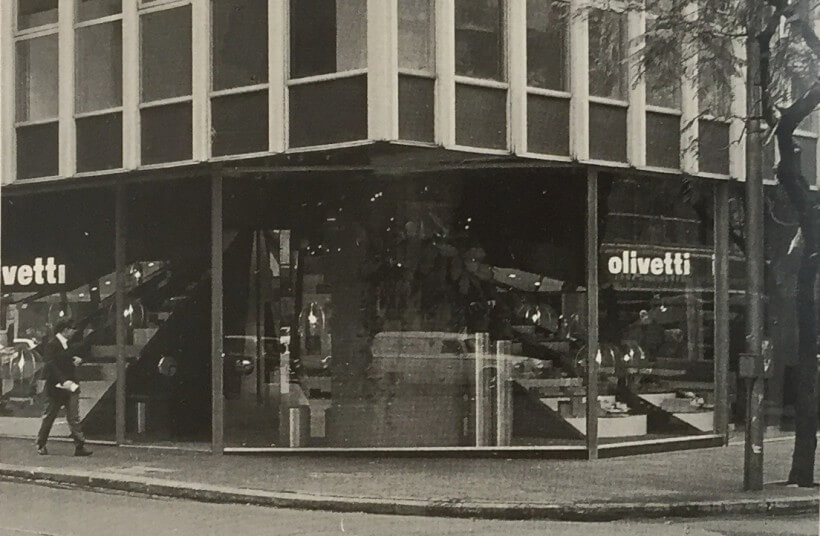 A shop designed by Gae Aulenti that created a genuine presence of Olivetti in Buenos Aires (source: Domus).
A shop designed by Gae Aulenti that created a genuine presence of Olivetti in Buenos Aires (source: Domus).
-
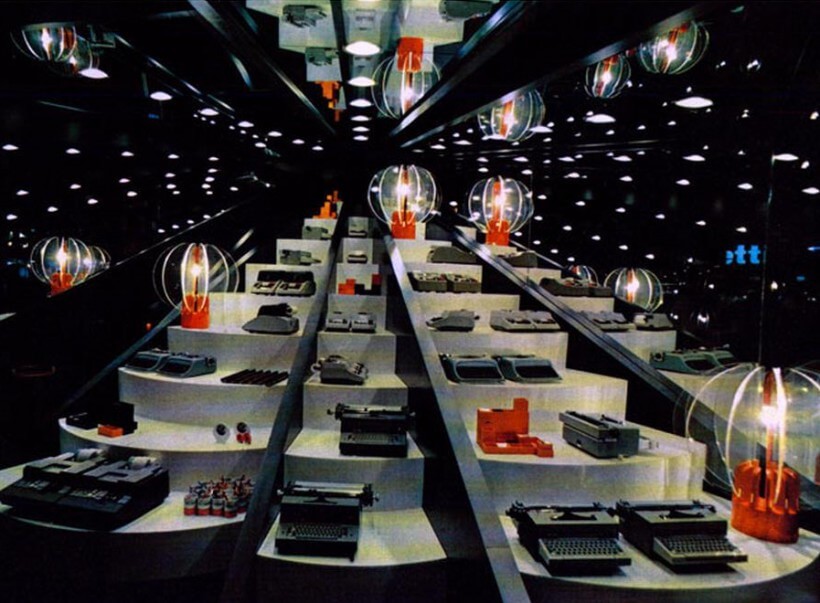 The Olivetti shop in Buenos Aires designed by Gae Aulenti in 1968 with her lamps “Re Sole” (source: Domus).
The Olivetti shop in Buenos Aires designed by Gae Aulenti in 1968 with her lamps “Re Sole” (source: Domus).
-
Everything was manufactured in Italy and shipped to Buenos Aires in special containers. Gae Aulenti also designed the so-called Re Sole (or in English ‘Sun King’) lamps, produced by Kartell.
-
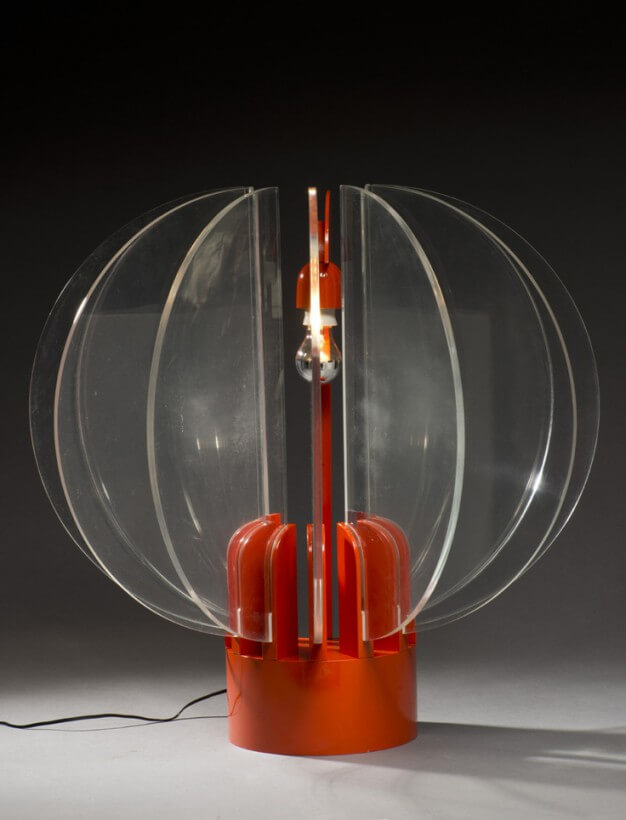 Like many of Aulenti’s designs the Re Sole Table Lamp is a mix of geometric forms, subtle sinuous lines and semicircular motifs.
Like many of Aulenti’s designs the Re Sole Table Lamp is a mix of geometric forms, subtle sinuous lines and semicircular motifs.
-
A brand new store in New York was a perfect opportunity for Olivetti to present the company to the American market. The objectives were clear to the architects Belgiojoso, Peressutti & Rogers when Adriano Olivetti entrusted them in 1954 with the task of setting up a shop on Fifth Avenue. The shop was to be an example of Italian avant garde, full of innovation, values and dynamic—also in terms of industrial and cultural experimentation.
-
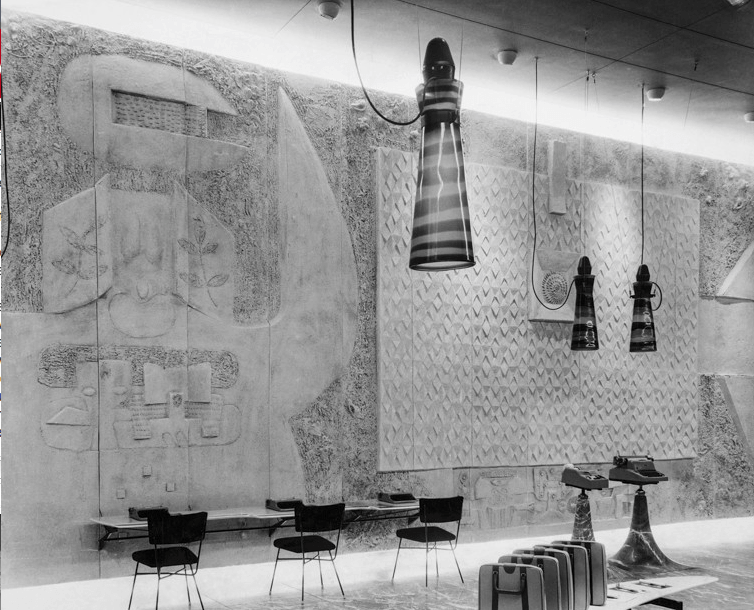 The most beautiful shop on Fifth Avenue with spectaculair Venini pendants, inaugurated June 1954 (source: Erich Hartmann).
The most beautiful shop on Fifth Avenue with spectaculair Venini pendants, inaugurated June 1954 (source: Erich Hartmann).
-
The colourful Murano glass pendants, produced by Venini, were elongated because of the 5-meter high ceiling. They seem stalactites opposed to the pink marmble columns used to display products and which, conversely, look like stalagmites that rise from the floor.
-
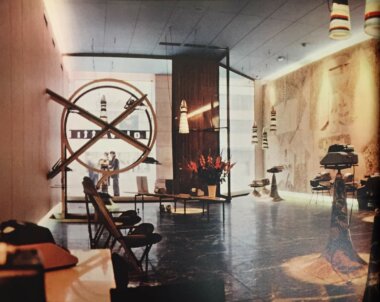 According to an article published in Domus No. 298 (Sept. 1954) the Olivetti shop in New York "…is an invention, is full of unusual and poetic values." (source: ‘Olivetti 1908-1958’ - Published by Olivetti & picture on the right: Jacksons).
According to an article published in Domus No. 298 (Sept. 1954) the Olivetti shop in New York "…is an invention, is full of unusual and poetic values." (source: ‘Olivetti 1908-1958’ - Published by Olivetti & picture on the right: Jacksons).
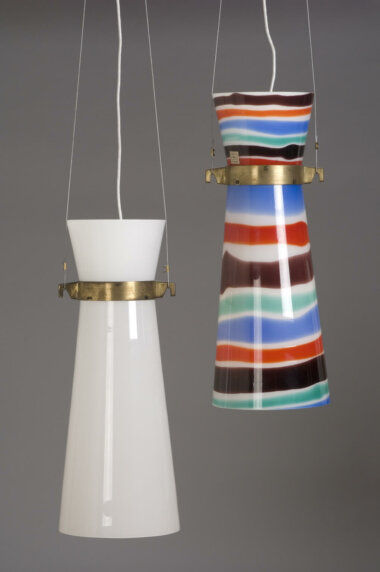
-
In 1959 Olivetti opened a store on Rue du Faubourg Saint-Honoré, just a step away from Palais de l’Élysée, the official residence of the President of the French Republic. In such an environment, the store offered a great opportunity to raise awareness of the company’s image. The task of developing this project was entrusted to Franco Albini (1905-1977), assisted by Franca Helg (1920-1989).
-
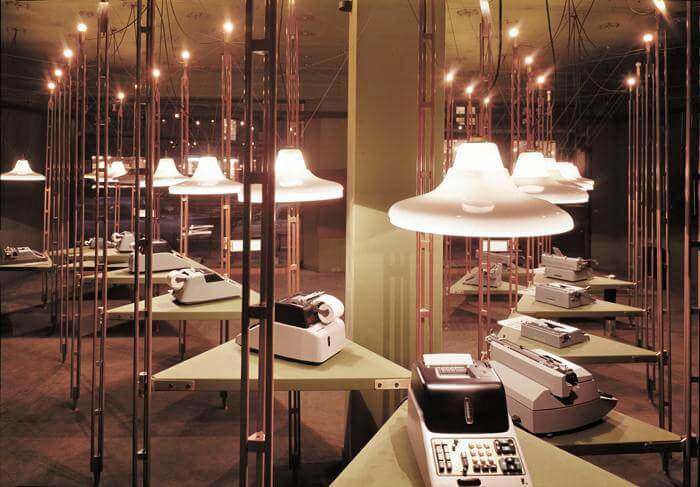 Numerous Venini chandeliers, in white glass from Murano and shaped like bellflowers, in the Paris store (Source: Olivetti).
Numerous Venini chandeliers, in white glass from Murano and shaped like bellflowers, in the Paris store (Source: Olivetti).
-
They were faced with a challenging task. The architecture of the new shop was rather cold and did not easily integrate with the historical buildings of the street. To create a welcoming atmosphere Albini and Helg covered the walls and ceiling with warm green-coloured cloth. The machines were displayed on triangular shelves, supported by light and elegant mahogany pillars. Grey velvet sofas and ebony tables completed the decor.
Given the large impact in terms of communication and image resulting from a high-end store located in a prestigious place, the company decided almost ten years later to give the exhibition a complete renewal. This time the honour was granted to Gae Aulenti.
-
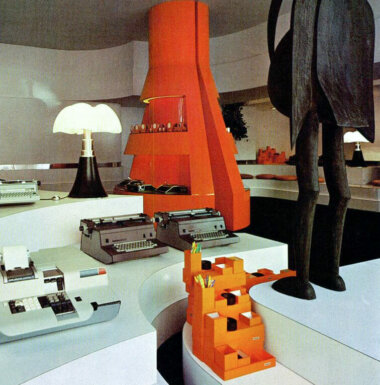
-
“The design of the showroom was born from the idea of making a ‘piazza’,” architect Gae Aulenti says in Domus No. 452 (July ’67). The steps on the sides recall the idea of staircases that lead to the houses, the red pillar in the centre reminds of a statue or fountain, which you often find in the middle of an Italian square and the wooden sculpture refers to humanity.
Referring to the idea that inspired the setting, Gae Aulenti expressed it as follows: “Within this multilevel, continuous space, there are three symbols around which the composition rotates: the stairs, which are an architectonic symbol of continuity; the central pillar, which leads the mind to the idea of the capsule, the form of the future; and Man, represented by the wooden African sculpture.”
-
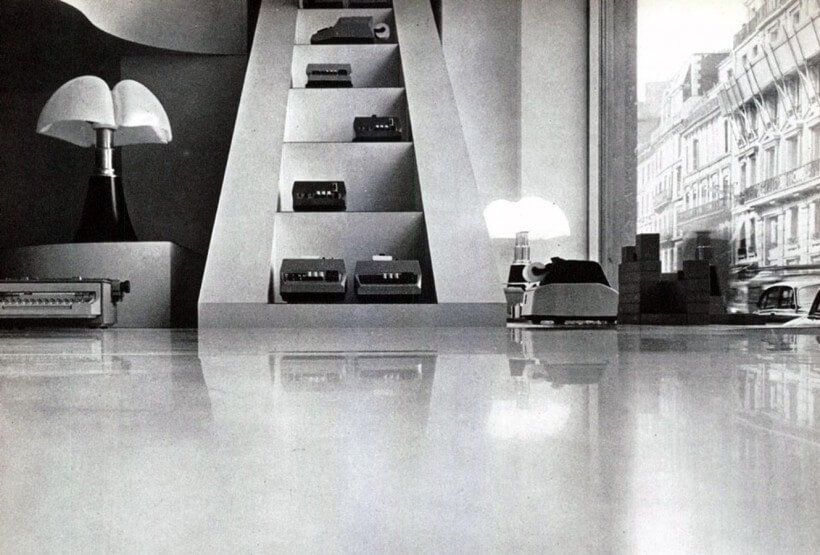 The Pipistrello Lamps not only improved the general illumination, but also made the store more interesting (source: Domus & Marchi Rolly).
The Pipistrello Lamps not only improved the general illumination, but also made the store more interesting (source: Domus & Marchi Rolly).
-
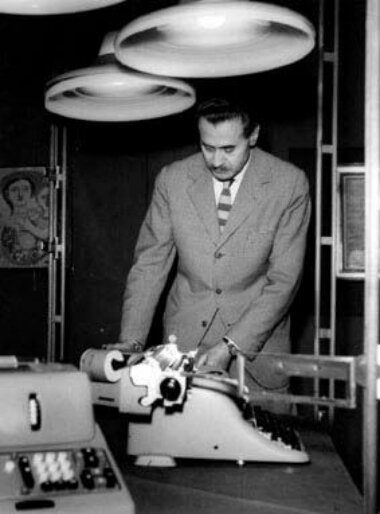 Franco Albini puts his final touches to the staging...
Franco Albini puts his final touches to the staging...
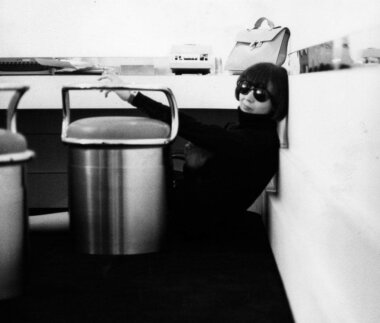 ...while Gae Aulenti already passed that stage (source: Domus & Marchi Rolly).
...while Gae Aulenti already passed that stage (source: Domus & Marchi Rolly).
-
For the design of the store in Düsseldorf Olivetti invited another great Italian architect, Ignazio Gardella (1905-1999). The shop was situated at the Königsallee, so in Düsseldorf Olivetti also chose a premium location in town.
The typewriters, calculators and other small devices were presented on eight round tables with rough surfaces of gilded copper that contrasted with the smooth and uniform surfaces of the machines.
In the centre of the room there was a huge Murano chandelier made by Venini. Lamps that were embedded in the ceiling lighted the tables and thus the products of Olivetti.
-
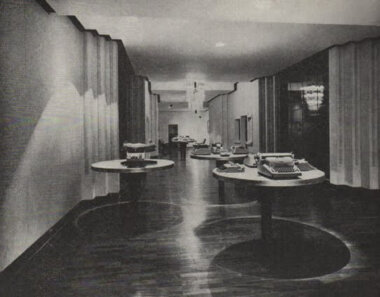 The Olivetti showroom in Düsseldorf designed by Ignazio Gardella in 1961 with a huge chandelier made by the Venetian glass factory Venini (both pictures from the Palainco archive).
The Olivetti showroom in Düsseldorf designed by Ignazio Gardella in 1961 with a huge chandelier made by the Venetian glass factory Venini (both pictures from the Palainco archive).
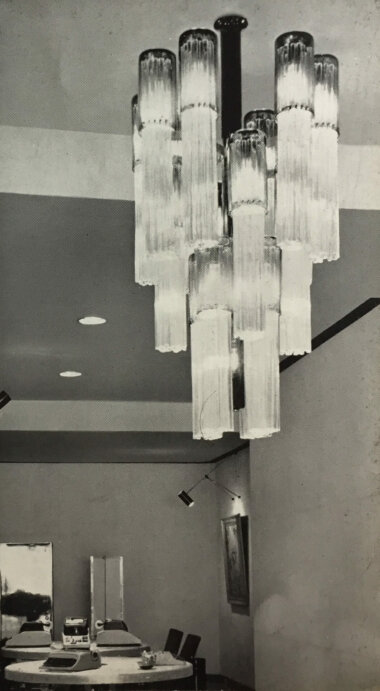
-
Eventually all stores had to be closed because of the excessive costs and the transition from mechanics to electronics, but what remains are fantastic lamps and of course… their exquisite typewriters.
-
If you would like to be the first to read articles on designers and special designs, please subscribe to our newsletter.
-
- Literature: Domus No. 298 (September 1954), Domus No. 452 (July 1967), Domus No. 466 (September 1968), ‘Olivetti 1908-1958’ - Published by Olivetti, Rome (1958), Storia Olivetti & Fondazione Adriano Olivetti.
Unless otherwise stated, all material is sourced and/or generated internally. All rights reserved.
- Text: Palainco, Koos Logger & Ingrid Stadler.
- Image sources: Olivetti, Domus, Marchi Rolly, Erich Hartmann, Jacksons, Venini, Olivetti 1908-1958, Austin Calhoon, Xavier & the Palainco Archive.
The article and its contents may not be copied or reproduced in any part or form without the prior written permission of the copyright holders.
Published on: 14 March 2016